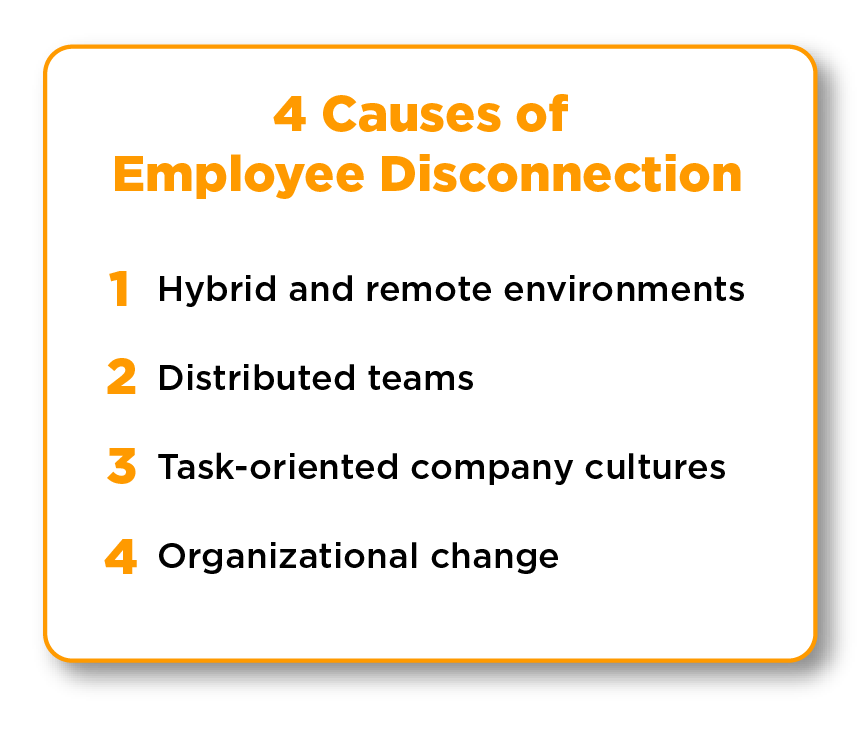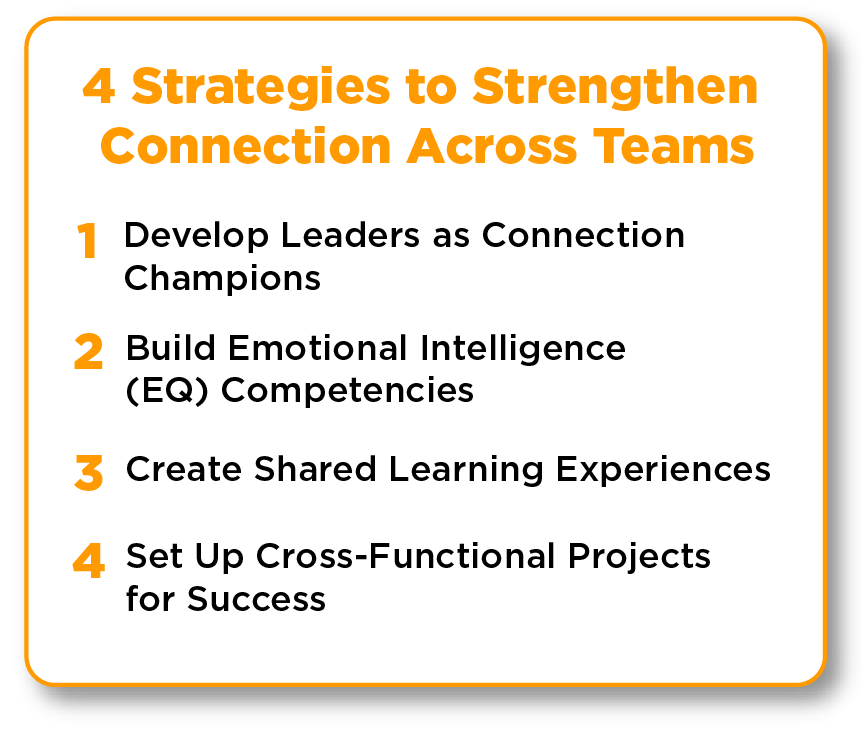Even though there are more collaboration tools and opportunities for digital connection than ever before, silos are becoming increasingly common across organizations. Leaders are seeing the effects as loneliness and employee disengagement are also on the rise [1].
Learning & Development (L&D) teams have an opportunity to address these challenges by developing programs that promote collaboration [2], empathy and belonging. When relationship building is woven into the organizational culture, it not only combats isolation; it drives performance, fuels innovation and aligns departments around a shared vision.
Over the past couple of weeks, my colleagues and I have been discussing the 9 Learning & Development Priorities for 2026 [3] from our recent guide. This week, I will highlight why organizations need to build connections across silos to succeed in 2026, and how you can get started.
The Growing Challenge of Disconnection in the Workplace
Silos are teams of people who are isolated from other parts of your business due to a limited flow of information [4]. In a study published by the Global Business Review, 83% of respondents reported that silos exist in their companies, and 97% said they negatively impact performance [5].
 Without careful attention, these barriers could become even more costly to organizations due to four factors.
Without careful attention, these barriers could become even more costly to organizations due to four factors.

#1 Hybrid and remote environments:
Let me start by saying I’m a big fan of remote and hybrid work models! Flexible options provide autonomy, balance and can boost productivity. They can also unintentionally reduce opportunities for spontaneous interaction and informal relationship- and community-building. Without intentional practices to maintain connection, workers may feel isolated from their teams or other departments and detached from the business’s strategic goals.
#2 Distributed teams
Whether it’s due to different work hours, languages or cultural norms, employees working across time zones and locations often face communication barriers and fewer shared experiences, which can make collaboration feel transactional rather than beneficial. If staff perceive that teamwork drives more operational inefficiencies than it does useful ideas and improved outcomes, coordination may stop completely, leading to duplicated efforts, misunderstandings and missed opportunities for creativity.
#3 Task-oriented company cultures
Organizations that hyperfocus on efficiency and output over engagement and cross-functional collaboration will likely notice that their employees are narrowly focused on immediate responsibilities, which contributes to a silo mentality. Without understanding how their work or others’ fit into the bigger picture, different departments may never hear about new ideas, potential improvements and innovations that often come from cross-functional teamwork.
#4 Organizational change
When there are major shifts in leadership or periods of restructuring, established networks and trust can be dismantled. Without fluid communication, intentional support and a shared understanding of what organizational success looks like, employees may feel uncertain about their role in the business, leading to disengagement and disconnection.
Why Connection Across Silos Matters
I’ve mentioned some of the challenges that come from siloed teams, and the data reinforces why these barriers are so detrimental to company success. Research shows that 73% of employees who collaborate do better work, and 60% say teamwork sparks innovation. [6] Organizations with collaborative cultures can see up to 21% higher profitability. [7]
In addition to the return on teamwork, there’s an emotional cost to disconnection that leadership teams may recognize. Disengagement is estimated to result in $8.8 trillion in lost productivity [8], so it literally pays to inspire staff by ensuring that they understand the important part they play in the overall success of the entire organization.
 Belonging is a human necessity [9]. We’re all driven by a need to connect and find meaning in what we do. The companies that invest in closing gaps between staff and empowering them to use their strengths to do better work will benefit from an engaged workforce, more innovative solutions and a more productive organization.
Belonging is a human necessity [9]. We’re all driven by a need to connect and find meaning in what we do. The companies that invest in closing gaps between staff and empowering them to use their strengths to do better work will benefit from an engaged workforce, more innovative solutions and a more productive organization.
From a personal perspective, I invite you to take a moment to reflect on your own work friendships, including those you may have on other teams. As you think of the trusted colleagues you turn to for ideas, feedback or encouragement, ask yourself: What would your job be like without them? How would your brainstorming, decision-making or projects shift if you didn’t have anyone to bounce ideas off of?
These cross-functional relationships may be easy to overlook in the pursuit of the bottom line, and they’re the glue that holds organizations together.
L&D Strategies to Strengthen Cross-Departmental Connection

Training professionals can reduce departmental silos by emphasizing mindset shifts to support employee engagement and encourage collaborative behaviors to elevate productivity. Four ways to get started include:
1. Develop Leaders as Connection Champions
Leaders set the tone for collaboration and inclusivity. By embedding human-centric practices into manager and leadership training [10], L&D can help participants see the value of team building [11] and build skills to promote trust and open communication. Leaders who prioritize relationships create psychologically safe environments, which can reduce siloed thinking as team members across departments feel encouraged to share ideas and perspectives. If you’re looking for a place to begin, consider equipping leaders with a simple tip sheet on encouraging cross-team collaboration.
2. Build Emotional Intelligence (EQ) Competencies
When personnel embrace emotional intelligence, [12] it can transform working relationships. EQ encompasses capabilities including self-awareness, motivation, empathy and social skills like communication and conflict resolution. With greater empathy, team members are more likely to feel connected to one another and the organization. Through increased social skills, individuals can experience the benefits of their collaborative efforts and the value that comes from embracing each other’s diverse skill sets. Using tools like the Emergenetics Profile to reveal thinking and behavioral preferences can be a great place to start.
3. Create Shared Learning Experiences
One of the most effective ways to foster collaboration and overcome organizational silos is through shared learning experiences. L&D can intentionally bring staff from different departments together to engage in skill building. By learning together, employees start to build trust, and team building exercises can support connection, engagement and motivation. Experiences like the Meeting of the Minds [13] can be a two-in-one, helping staff gain mutual understanding while also elevating valuable collaboration and communication skills.
4. Set Up Cross-Functional Projects for Success
When teams learn how to work together positively to advance common company goals, it can break down the silo mentality. L&D can facilitate cross-functional projects that align departments and encourage collaboration on meaningful initiatives. One way to begin is to use project kick-offs as an opportunity to review preferred working styles, explore how different functions operate and set team norms to realize successful outcomes. L&D can lead these discussions to identify common working agreements and to determine how to leverage the innate strengths and group tendencies of the contributors to produce better results.
The Future of Connection in Learning and Development
As we look ahead to 2026, the organizations that will thrive are those that encourage team members to break down silos. The results are a win-win! Employees will feel more engaged and motivated to support their departmental and company goals. They will also feel encouraged to use each other’s diverse perspectives to improve decision-making and advance innovative ideas, which in turn supports the business’s success.
Learning & Development plays a vital role in creating a unified company culture where human-centricity, collaboration and belonging intersect. By investing in strategies that dismantle silos, you’ll be well on your way to transforming isolated teams into cohesive, high-performing networks.
Explore how Emergenetics programs can help your organization in breaking down silos and building bridges across different teams. Contact our staff today. [14]
FAQs
1. What does “connection across silos” mean in the workplace?
Creating connections across silos means generating a seamless flow of information, idea-sharing and collaboration across every level and department of the organization.
2. How can Learning & Development help break down silos between departments?
By designing team-building experiences across departments, upskilling staff with stronger emotional intelligence and communication competencies and offering shared learning experiences that mix functions and geographies, all with the goal of boosting cross-functional collaboration and a sense of community.
3. Why is employee connection important in hybrid or remote teams?
Employee connection is important for every team, and especially important for hybrid or remote teams, as employees are more likely to feel isolated or disconnected from the broader organization. [15]
4. How can organizations measure success in building connection across silos?
Organizations can measure success by analyzing engagement scores from eNPS surveys, employee retention data, cross-team project success and collecting input on communication frequency.
5. How can Emergenetics help teams break down organizational silos?
The Emergenetics Profile [16] reveals employees‘ Thinking and Behavioral preferences. Through our workshops and eLearnings, we change the way teams operate by giving them new tools to communicate, collaborate and engage in a positive, productive way based on these different perspectives. Our solutions are also a powerful way to support team building and enhance psychological safety, which elevates a sense of belonging and connection across the entire organization.
To learn more about the L&D trends shaping the future of work, download our full guide [3] and follow along with our blog series.
